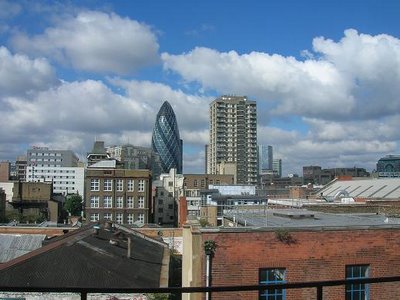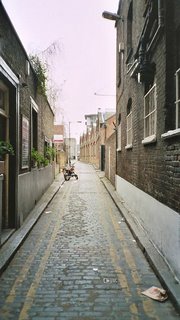George Yard Buildings
 This small section of blue wall is all that remains of George Yard Buildings today. This is the corner where George Yard, or Gunthorpe Street as it is today, meets Wentworth Street. On or near this corner, at around 2am, PC Thomas Barrett (226H) encountered a soldier loitering in the street. Barrett asked him what his business was there, and he replied that he was "waiting for a chum who had gone off with a girl." It seems unlikely that this was either of the two soldiers who had spent the last part of the evening with Martha Tabram and Pearly Poll, but it was considered suspicious enough to be thoroughly investigated by detectives looking into Martha's murder.
This small section of blue wall is all that remains of George Yard Buildings today. This is the corner where George Yard, or Gunthorpe Street as it is today, meets Wentworth Street. On or near this corner, at around 2am, PC Thomas Barrett (226H) encountered a soldier loitering in the street. Barrett asked him what his business was there, and he replied that he was "waiting for a chum who had gone off with a girl." It seems unlikely that this was either of the two soldiers who had spent the last part of the evening with Martha Tabram and Pearly Poll, but it was considered suspicious enough to be thoroughly investigated by detectives looking into Martha's murder.At around 3.30, a cab driver named Alfred Crow, who lived in room number 35 in the buildings, was returning home from work, tired and ready for his bed. As he passed up the stairs he was aware that somebody was lying on the first floor landing. He paid it no attention, as it was dark and drunks and homeless people often crept in to sleep on the stairs at night.
John Reeves lived in room 37. He was a casual dock labourer, which meant in those days that he would have to be up early and join the crowds around the docks hoping to be one of the lucky ones picked for a day's work. He left his room at a quarter to five that morning. When he reached the first floor landing, he saw Martha lying there, surrounded by a pool of blood.
She was lying on her back, with her arms by her side and her legs wide open. Her clothes were in disarray, pulled up so as to expose the whole lower half of her body. Reeves could see at a glance that she was dead, and so, without stopping to examine the body, he quickly ran out into the street where he located PC Barrett, still on patrol, and alerted him to what he had found.







